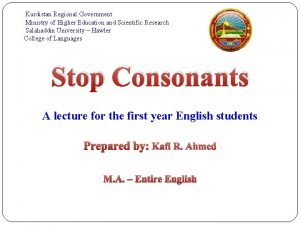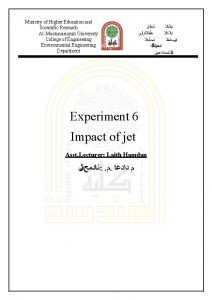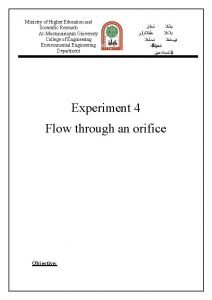Ministry of Higher Education and Scientific Research AlMustansiriayah



- Slides: 3

Ministry of Higher Education and Scientific Research Al-Mustansiriayah University College of Engineering Environmental Engineering Department ﺛﺤﺒﻼﻭ ﻳﻤﻠﻌﻼ ﻣﻴﻠﻌﺘﻼةﺮﺍﺯﻭ ﻳﻼﻋﻼ ﺗﻌﻤﺎﺟﻼ ﺗﻴﺮﺻﻨﺘﺴﻤﻼ ﺗﺴﺪﻧﻬﻼﻠﻴﺗﻚ ﺒﻴﺌةﻼةﺴﺪﻧﻪ ﻣﺴﻖ Experiment 2 Calibration of Bourdon Gauge Asst. Lecturer: Laith Hamdan ﻧﺎﺩﻣﺢ ﺛﻴﻞ : . ﻡ. ﻡ ﺩﺍﺩﻋﺎ

Objective: To calibrate bourdon gauge device. Equipments and apparatus: The Bourdon pressure gauge shown in Figure below has a transparent dial through which the construction may be viewed. It consists essentially of a thin-walled tube of oval cross-section, which is bent to a circular arc encompassing approximately 270'. It is rigidly held at one end, when the pressure is admitted. The other end is free to move and is sealed. When pressure is applied, the tube tends to straighten, so that the free end moves slightly. This movement operates a mechanism which drives a pointer round the graduated dial, the movement of the pointer being proportional to the applied pressure. The construction of the dead weight tester is also shown in figure below. A cylindrical piston, free to move vertically in a closely-fitting cylinder, is loaded with known weights. The space below the piston is filled with water, and the pressure is transmitted by the water to the gauge under test through a transparent hose. The pressure generated by the piston is easily found in terms of the total weight supported and the cross-sectional area of the piston. Asst. Lecturer: Laith Hamdan ﺗﺤﻔﺼﻼ 1

Procedure: The weight of the piston, and its cross-sectional area, should be noted. To full the cylinder, the piston is removed, and water is poured into the cylinder until it is full to the overflow level. Any air trapped i 1 the tube may be cleared by tilting and gently tapping the apparatus. In point of fact. A small amount of air left in the system will not affect the experiment, unless there is so much as to cause the piston to bottom on the base of the cylinder. The piston is then replaced in the cylinder and allowed to settle. A spirit level placed on the platform at the top of the pistol may be used to ensure that the cylinder stands quite vertically. Weights are now added in convenient increments, and at each increment the pressure gauge leading is observed. A similar set of results is then taken with decreasing weights. To guard against the piston sticking in the cylinder, it is advisable to rotate the piston gently while the pressure gauge is being read. Theoretical background and Calculation: mass of piston : 1 kg , weight of piston =9. 81 N Cross-sectional area = 333 mm 2 = 0. 333 x 10 -3 m 2 True Pressure = Force (weight of piston) / Area Error % = gauge Pressure - True Pressure Efficiency % = ( (gauge Pressure - True Pressure) / gauge Pressure) × 100 Asst. Lecturer: Laith Hamdan ﺗﺤﻔﺼﻼ 2





